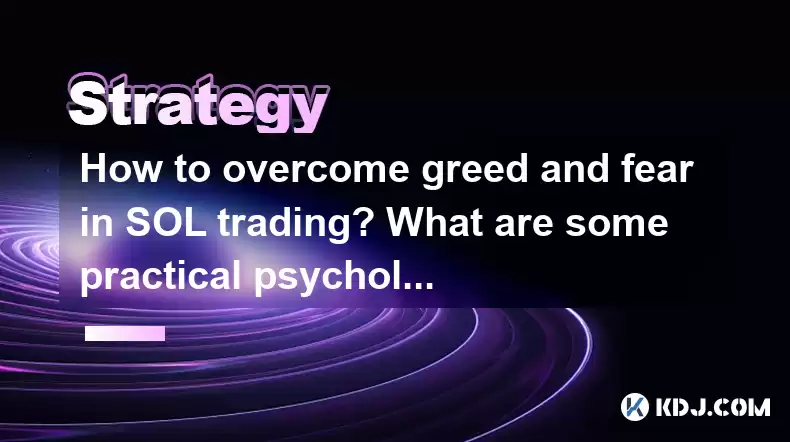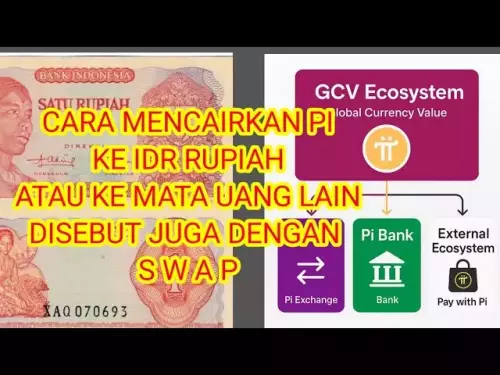-
 bitcoin
bitcoin $112715.707551 USD
-1.71% -
 ethereum
ethereum $4101.475385 USD
-3.01% -
 tether
tether $1.000644 USD
-0.02% -
 bnb
bnb $1207.619465 USD
-6.77% -
 xrp
xrp $2.501451 USD
-3.98% -
 solana
solana $202.947124 USD
-3.32% -
 usd-coin
usd-coin $1.000295 USD
0.04% -
 dogecoin
dogecoin $0.203884 USD
-4.47% -
 tron
tron $0.317154 USD
-1.72% -
 cardano
cardano $0.695009 USD
-4.43% -
 hyperliquid
hyperliquid $38.853961 USD
-8.23% -
 chainlink
chainlink $18.988674 USD
-4.64% -
 ethena-usde
ethena-usde $1.000233 USD
-0.03% -
 stellar
stellar $0.337050 USD
-3.63% -
 bitcoin-cash
bitcoin-cash $536.861728 USD
-1.28%
How to overcome greed and fear in SOL trading? What are some practical psychological skills?
Overcome greed and fear in SOL trading by developing emotional awareness, implementing risk management, and cultivating a long-term perspective.
Apr 28, 2025 at 08:49 pm

Trading in cryptocurrencies like Solana (SOL) can be an exhilarating yet challenging endeavor, primarily due to the emotional rollercoaster that traders often experience. Greed and fear are two of the most potent emotions that can significantly impact trading decisions and outcomes. Overcoming these emotions requires a deep understanding of one's psychological state and the application of practical skills to maintain a balanced approach to trading. This article will explore how to overcome greed and fear in SOL trading and provide some practical psychological skills to help traders navigate the volatile crypto market.
Understanding Greed and Fear in Trading
Greed in trading often manifests as an insatiable desire for more profits, leading traders to take excessive risks or hold onto winning positions for too long. On the other hand, fear can cause traders to sell prematurely or avoid taking necessary risks, resulting in missed opportunities. Both emotions can cloud judgment and lead to irrational decision-making.
To effectively manage these emotions, it's crucial to recognize their presence and understand how they influence your trading behavior. Keeping a trading journal can be an excellent way to track your emotional responses to market movements and identify patterns that may indicate when greed or fear is driving your decisions.
Developing Emotional Awareness
The first step in overcoming greed and fear is to develop a heightened sense of emotional awareness. This involves regularly checking in with your emotions and acknowledging them without judgment. By doing so, you can begin to separate your emotional responses from your trading decisions.
- Practice mindfulness: Spend a few minutes each day practicing mindfulness meditation. This can help you become more aware of your thoughts and emotions, allowing you to better manage them during trading.
- Use emotional check-ins: Before making any trading decision, take a moment to assess your current emotional state. Ask yourself if you are feeling greedy or fearful and consider how these emotions might be influencing your decision.
Implementing Risk Management Strategies
Effective risk management is a critical component of overcoming greed and fear. By setting clear risk parameters, you can reduce the emotional impact of market fluctuations and make more rational trading decisions.
- Set stop-loss orders: A stop-loss order can help you limit potential losses by automatically selling a position when it reaches a predetermined price level. This can prevent fear from causing you to hold onto a losing position for too long.
- Define profit targets: Similarly, setting profit targets can help you avoid the greed that might lead you to hold onto a winning position indefinitely. By selling when a position reaches your target, you can lock in profits and reduce the emotional pressure of deciding when to sell.
Cultivating a Long-Term Perspective
Adopting a long-term perspective can help mitigate the impact of short-term market volatility and reduce the influence of greed and fear. Instead of focusing on daily price movements, consider the broader trends and fundamentals of SOL and the cryptocurrency market as a whole.
- Focus on fundamentals: Regularly review the fundamental factors that drive SOL's value, such as network growth, adoption rates, and technological developments. This can help you make more informed trading decisions based on long-term potential rather than short-term price fluctuations.
- Diversify your portfolio: By diversifying your investments across different assets, you can reduce the emotional impact of price swings in any single asset. This can help you maintain a more balanced approach to trading and reduce the influence of greed and fear.
Practicing Discipline and Patience
Discipline and patience are essential qualities for any successful trader. By adhering to a well-defined trading plan and resisting the urge to make impulsive decisions, you can better manage the emotions of greed and fear.
- Create a trading plan: Develop a comprehensive trading plan that outlines your entry and exit strategies, risk management rules, and long-term goals. Stick to this plan even when emotions are running high.
- Take breaks: If you find yourself becoming overly emotional during trading, take a break. Step away from the screen and engage in activities that help you relax and regain perspective.
Utilizing Psychological Techniques
Several psychological techniques can help you manage greed and fear more effectively. These techniques can be integrated into your daily trading routine to enhance your emotional resilience.
- Cognitive restructuring: This technique involves identifying and challenging irrational thoughts that may be driving your emotional responses. For example, if you find yourself thinking, 'I must make a profit on every trade,' challenge this thought by considering the reality of trading and the inevitability of losses.
- Visualization: Visualize yourself successfully managing your emotions and making rational trading decisions. This can help reinforce positive behaviors and reduce the impact of negative emotions.
- Positive affirmations: Use positive affirmations to reinforce your confidence and resilience. Statements like 'I am in control of my emotions' or 'I make rational trading decisions' can help you maintain a positive mindset.
Building a Support Network
Trading can be a lonely endeavor, and having a support network can be invaluable in managing emotions like greed and fear. Connecting with other traders can provide you with new perspectives, emotional support, and accountability.
- Join trading communities: Participate in online forums, social media groups, or local meetups where you can share experiences and learn from other traders.
- Find a trading mentor: A mentor can offer guidance, share their experiences, and help you stay accountable to your trading plan.
FAQs
Q: How can I tell if I'm making decisions based on greed or fear?A: One way to determine if your decisions are driven by greed or fear is to review your trading journal. Look for patterns where you've made impulsive decisions or deviated from your trading plan. If you notice that you're consistently holding onto winning positions for too long or selling too early, these could be signs of greed or fear, respectively.
Q: Can using trading bots help manage emotions?A: Trading bots can help by executing trades based on predefined criteria, which can reduce the emotional impact of making decisions in real-time. However, it's important to monitor and adjust the bot's settings regularly to ensure they align with your overall trading strategy and risk tolerance.
Q: How often should I review my trading plan?A: It's a good practice to review your trading plan at least once a week. This allows you to assess your performance, make necessary adjustments, and reinforce your commitment to disciplined trading.
Q: Are there any specific books or resources you recommend for learning more about trading psychology?A: Yes, several books can provide valuable insights into trading psychology. 'Trading in the Zone' by Mark Douglas is highly recommended for its focus on the mental aspects of trading. Additionally, 'The Psychology of Trading' by Brett N. Steenbarger offers practical advice on managing emotions and improving trading performance.
Disclaimer:info@kdj.com
The information provided is not trading advice. kdj.com does not assume any responsibility for any investments made based on the information provided in this article. Cryptocurrencies are highly volatile and it is highly recommended that you invest with caution after thorough research!
If you believe that the content used on this website infringes your copyright, please contact us immediately (info@kdj.com) and we will delete it promptly.
- Zero Knowledge Proof, Whitelist, Blockchain 2025: The Dawn of Private, Scalable Infrastructure
- 2025-10-16 01:20:01
- Altcoins, Whales, and Tariff Threats: Navigating the Crypto Seas
- 2025-10-16 01:20:01
- ChatGPT's Crystal Ball: HBAR Price Prediction and the Rise of Snorter in 2025
- 2025-10-16 01:20:01
- ZEROBASE Listing and Airdrop: A New Era for ZK Tech?
- 2025-10-16 00:25:13
- Digital Euro, Gold Standard, and Active Reserves: A New York Minute on the Future of Money
- 2025-10-16 00:25:13
- TCG OTS Pack Spoilers: What's Hot and What's Not?
- 2025-10-16 00:33:47
Related knowledge

Practical parameter settings for a Bitcoin multi-timeframe moving average system
Sep 18,2025 at 10:54pm
Optimizing Timeframe Combinations for Bitcoin Trading1. Selecting appropriate timeframes is crucial when building a multi-timeframe moving average sys...

How can I filter out false breakouts in Dogecoin high-frequency trading?
Sep 22,2025 at 01:00am
Understanding False Breakouts in Dogecoin Trading1. A false breakout occurs when Dogecoin's price appears to move beyond a defined support or resistan...

Techniques for identifying tops and bottoms in the Bitcoin on-chain NVT model
Sep 20,2025 at 07:54pm
Understanding the NVT Model in Bitcoin Analysis1. The Network Value to Transactions (NVT) ratio is often described as the 'P/E ratio' of the cryptocur...

What does the surge in open interest in Bitcoincoin futures mean?
Sep 20,2025 at 11:18pm
Understanding the Surge in Dogecoin Futures Open Interest1. A surge in open interest within Dogecoin futures indicates a growing number of active cont...

How can I use the Ethereum USDT premium to gauge market sentiment?
Sep 18,2025 at 11:55pm
Understanding the Ethereum USDT Premium1. The Ethereum USDT premium refers to the price difference between USDT (Tether) traded on Ethereum-based plat...

What should I do if Ethereum staking yields decline?
Sep 20,2025 at 06:18am
Understanding the Causes Behind Declining Ethereum Staking Yields1. The Ethereum network transitioned to a proof-of-stake consensus mechanism with the...

Practical parameter settings for a Bitcoin multi-timeframe moving average system
Sep 18,2025 at 10:54pm
Optimizing Timeframe Combinations for Bitcoin Trading1. Selecting appropriate timeframes is crucial when building a multi-timeframe moving average sys...

How can I filter out false breakouts in Dogecoin high-frequency trading?
Sep 22,2025 at 01:00am
Understanding False Breakouts in Dogecoin Trading1. A false breakout occurs when Dogecoin's price appears to move beyond a defined support or resistan...

Techniques for identifying tops and bottoms in the Bitcoin on-chain NVT model
Sep 20,2025 at 07:54pm
Understanding the NVT Model in Bitcoin Analysis1. The Network Value to Transactions (NVT) ratio is often described as the 'P/E ratio' of the cryptocur...

What does the surge in open interest in Bitcoincoin futures mean?
Sep 20,2025 at 11:18pm
Understanding the Surge in Dogecoin Futures Open Interest1. A surge in open interest within Dogecoin futures indicates a growing number of active cont...

How can I use the Ethereum USDT premium to gauge market sentiment?
Sep 18,2025 at 11:55pm
Understanding the Ethereum USDT Premium1. The Ethereum USDT premium refers to the price difference between USDT (Tether) traded on Ethereum-based plat...

What should I do if Ethereum staking yields decline?
Sep 20,2025 at 06:18am
Understanding the Causes Behind Declining Ethereum Staking Yields1. The Ethereum network transitioned to a proof-of-stake consensus mechanism with the...
See all articles










































































